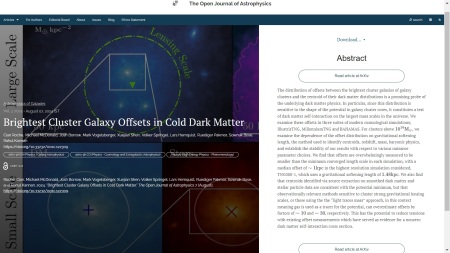https://openjdk.org/jeps/519 #JEP #JavaDevelopment #CompactObjects #TechHumor #HackerNews #ngated
https://openjdk.org/jeps/519 #JEP #JavaDevelopment #CompactObjects #TechHumor #HackerNews #ngated
It’s Saturday so it’s time once again for another roundup of business at the Open Journal of Astrophysics. After last week’s summer lull, this week I have three papers to announce, which brings the total we have published so far this year (Vol. 7) to 67 and the total published by OJAp to 182.
First one up, published on 7th August 2024, is “Brightest Cluster Galaxy Offsets in Cold Dark Matter” by Jonathan Katz of Washington University (St Louis, Missouri, USA), a simulation-based study of the distribution of the position of brightest cluster galaxies relative to the dark matter distribution and its possible use as a cosmological probe. The authors are Cian Roche (MIT), Michael McDonald (MIT), Josh Borrow (MIT), Mark Vogelsberger (MIT), Xuejian Shen (MIT), Volker Springel (MPA Garching), Lars Hernquist (Harvard), Ruediger Pakmor (Harvard), Sownak Bose (Durham, UK) and Rahul Kannan (York U., Canada). This paper is in the folder marked Astrophysics of Galaxies.
Here is a screen grab of the overlay, which includes the abstract:
You can read the paper directly on arXiv here.
The second paper to present is “LAMOST J1010+2358 is not a Pair-Instability Supernova Relic” by five authors based in the USA: Pierre Thibodeaux (Chicago), Alexander P. Ji (Chicago), William Cerny (Yale), Evan N. Kirby (Notre Dame) and Joshua D. Simon (Carnegie Observatories) . As the title makes clear, the paper presents arguments against previous claims that a particular star is not a pair-instability supernova relic. This paper is in the folder marked Solar and Stellar Astrophysics. It was published on Friday August 9th 2024.
The overlay looks like this:
You can read this paper directly on the arXiv here.
Last, but by no means least, comes “A Pilot Search for Gravitational Self-Lensing Binaries with the Zwicky Transient Facility“, results of a trial search for signals of gravitational lensing of one component in a binary system by a compact companion, with a discussion of future prospects for larger surveys. This one, which was also published on 9th August, is in the folder marked High-Energy Astrophysical Phenomena. The authors are Allison Crossland & Eric C Bellm (U. Washington), Courtney Klein (UC Irvine), James R. A. Davenport (U. Washington), Thomas Kupfer (Hamburg Observatory) and Steven L. Groom, Russ R. Laher & Reed Riddle (Caltech).
Here is a screengrab of the overlay:
To read the accepted version of this on the arXiv please go here.
That’s it for this week. I hope to post another update next weekend.
https://telescoper.blog/2024/08/10/three-new-publications-at-the-open-journal-of-astrophysics-10/
#arXiv231117862v2 #arXiv240200928v3 #arXiv240417078v2 #AstrophysicsOfGalaxies #binarySystems #BrightestClusterGalaxies #ColdDarkMatter #compactObjects #Cosmology #GravitationalLensing #HighEnergyAstrophysicalPhenomena #LAMOSTJ10102358 #pairInstabilitySupernova #SolarAndStellarAstrophysics #ZwickyTransientFacility
🫥 New simulations reveal hot neutrinos trapped during neutron star collisions
https://phys.org/news/2024-06-simulations-reveal-hot-neutrinos-neutron.html
New simulations reveal hot neutrinos trapped during neutron star collisions
When stars collapse, they can leave behind incredibly dense but relatively small and cold remnants called neutron stars. If two stars collapse in close proximity, the leftover binary neutron stars spiral in and eventually collide, and the interface where the two stars begin merging becomes incredibly hot.
